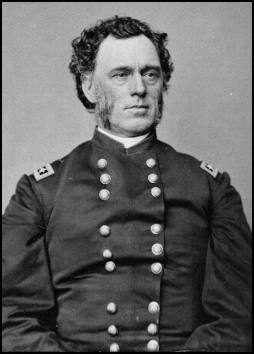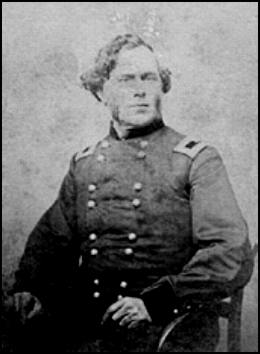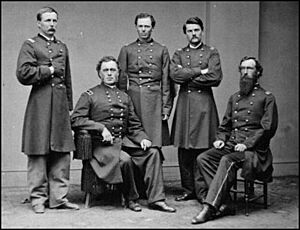James B. Steedman facts for kids
Quick facts for kids
James Blair Steedman
|
|
|---|---|
 |
|
| Nickname(s) | Steady |
| Born | July 29, 1817 Northumberland County, Pennsylvania |
| Died | October 18, 1883 (aged 66) Toledo, Ohio |
| Place of burial |
Woodlawn Cemetery, Toledo, Ohio
|
| Allegiance | |
| Service/ |
Texian Army United States Army |
| Years of service | 1835 (Texas Army) 1861–1866 (U.S.) |
| Rank | |
| Commands held | 14th Ohio Infantry |
| Battles/wars | Texas War of Independence American Civil War |
| Other work | Ohio legislator, printer, Toledo police captain |
James Blair Steedman (born July 29, 1817 – died October 18, 1883) was an important American figure. He was a printer, a builder, and a lawyer. During the Civil War, he became a brave general in the Union Army.
Before the Civil War, Steedman fought in the Texas War of Independence. He then returned to Ohio. There, he worked in the state government. He was also in charge of public works projects. Even though he tried, he did not become a U.S. Congressman.
As a colonel, Steedman led a group of soldiers early in the Civil War. They fought in western Virginia in 1861. Later, he became a brigadier general. He was praised for saving many soldiers at the Battle of Perryville in Kentucky. At the tough Battle of Chickamauga in Tennessee, he helped General George Thomas. Steedman was key in saving the Union forces after a big defeat. He fought again with General Thomas at Nashville in 1864. His actions helped the Union win a major victory that ended the war in the west.
Contents
Early Life and Education
James Steedman was born in Northumberland County, Pennsylvania. This was in the summer of 1817. He was the second of five children. James did not go to school much when he was young. He learned mostly by working.
From Printer to Politician
When James was fifteen, both of his parents died. To support his brothers and sisters, he became a typesetter. He worked for a newspaper in Lewisburg, Pennsylvania. Two years later, he moved to Louisville, Kentucky. He continued working as a typesetter there.
Steedman worked as a printer until 1835. Then, he joined the Texas Army. He fought in the Texas War of Independence. After the war, he went back to Pennsylvania. He worked as a supervisor on public building projects.
In 1835, Steedman moved to Ohio. He wanted to become a building contractor. It was hard to get contracts at first. So, he bought a printing press in Napoleon, Ohio. In 1838, he started his own newspaper. During this time, he married Miranda Slides. Soon, he started getting building contracts. His company built parts of the Wabash and Erie Canal. They also built sections of the Toledo, Wabash and Western Railway.
Steedman started his political career in 1847. He was elected to the Ohio General Assembly twice. After that, he worked as a railroad conductor. In 1849, he went to California for the California Gold Rush. He hoped to find gold. But it was difficult, so he returned to Ohio in 1850.
He was then appointed to Ohio's public works board. He served from 1852 to 1857. For three of those years, he was the president. During this time, he also became a lawyer. He opened a law office in Toledo. Steedman also edited a newspaper. In 1857, he became a major general in the Ohio State Militia. He held these jobs until the Civil War began in 1861. From 1856 to 1860, he also worked as a printer for the United States Congress.
In 1860, Steedman was part of Ohio's group at the Democratic National Convention. He strongly supported Stephen Douglas. He also ran for the U.S. House of Representatives. He lost that election.
Civil War Service
When the Civil War started in 1861, Steedman joined the Union Army. He gathered a group of soldiers. On April 27, he was chosen as their colonel. This group was the 14th Ohio Infantry. They first fought in June 1861. This was at the Battle of Philippi in West Virginia.
Steedman and his soldiers then moved to the Western Theater. They fought in the Battle of Mill Springs in January 1862. They also took part in the Siege of Corinth in Mississippi. On July 17, 1862, Steedman became a brigadier general. He was given command of a brigade in the Army of the Ohio.
Key Battles and Victories
After the Battle of Shiloh, Steedman's brigade joined General Don Carlos Buell's army. This was in Kentucky in the fall of 1862. During the Battle of Perryville on October 8, his soldiers helped a division. They filled a gap in the Union line. This saved the division from being defeated. General Buell praised Steedman for his actions.
Steedman and his brigade also fought at the Battle of Stones River. This battle took place from December 1862 to January 1863.
The Battle of Chickamauga
In the fall of 1863, Steedman fought in the Battle of Chickamauga in Georgia. He led his division to help General George Henry Thomas. This was on September 20. General Granger, without orders, sent Steedman's men to help Thomas. The rest of the Union army was retreating.
Steedman arrived quickly, just in time. He stopped Confederate General James Longstreet's attack. Many historians say Steedman showed great courage. He prevented a Union defeat from becoming a disaster. He was wounded when his horse was shot.
Later in 1863, Steedman was part of the Siege of Chattanooga. He also fought in the Third Battle of Chattanooga. He stayed in Chattanooga, leading all forces there. On April 20, he was promoted to major general. Steedman also took part in much of the Atlanta Campaign.
The Battle of Nashville
Steedman fought with General Thomas's army at the Battle of Nashville. This was on December 15–16, 1864. Steedman led a special division of 11 regiments. He had arrived by train from Chattanooga with about 6,000 men. He was the only major commander at Nashville who did not graduate from West Point.
General Thomas ordered Steedman to make a fake attack. This was on December 15. The goal was to keep the Confederate army busy. This would stop them from helping other parts of their line. On December 16, Steedman's men attacked again. They faced heavy losses. One of his regiments lost 221 men. This was the most of any regiment that day. When the rest of Thomas's army broke through, Steedman's men helped. They overwhelmed the Confederate forces. This led to a huge Union victory.
After Nashville, Steedman returned to Etowah. Then he commanded the Department of Georgia. He stayed in the Army until he resigned on August 18, 1866.
Life After the War
After leaving the Army, Steedman went back to Ohio in 1866. President Andrew Johnson appointed him to collect taxes in New Orleans. He held this job until 1869. He then returned to Toledo. He became the editor of a local newspaper. In 1870, he was elected to the Ohio State Senate.
In May 1883, he was made the Chief of Police in Toledo. He served in this role until he passed away.
Death and Legacy
James Steedman died in Toledo in 1883. He is buried in Woodlawn Cemetery there. A monument stands in Toledo to honor him.






